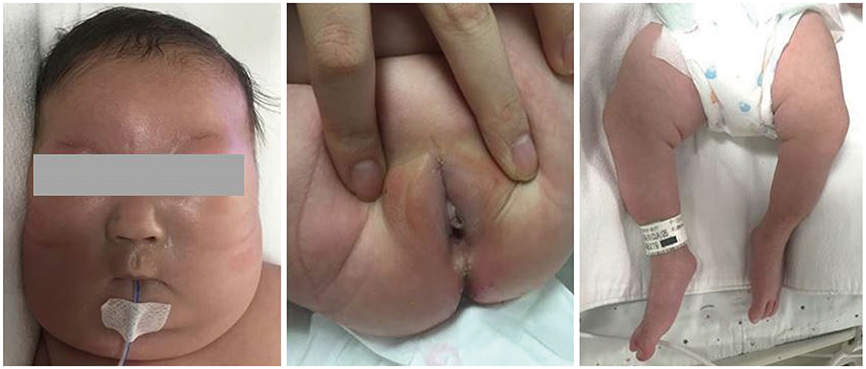Yonsei Med J.
2019 Apr;60(4):395-398. 10.3349/ymj.2019.60.4.395.
Genitopatellar Syndrome Secondary to De Novo KAT6B Mutation: The First Genetically Confirmed Case in South Korea
- Affiliations
-
- 1Department of Pediatrics, Severance Children's Hospital, Yonsei University College of Medicine, Seoul, Korea.
- 2Division of Neonatology, Department of Pediatrics, Severance Children's Hospital, Yonsei University College of Medicine, Seoul, Korea. HSEUN@yuhs.ac
- 3Division of Clinical Genetics, Department of Pediatrics, Severance Children's Hospital, Yonsei University College of Medicine, Seoul, Korea.
- KMID: 2450196
- DOI: http://doi.org/10.3349/ymj.2019.60.4.395
Abstract
- Genitopatellar syndrome (GPS) is a rare disorder characterized by patellar hypoplasia, flexion contractures of the lower limbs, psychomotor retardation and genital and renal anomalies. We report the case of a female infant diagnosed with GPS to a KAT6B gene mutation, which was identified using whole exome sequencing.
Keyword
Figure
Reference
-
1. Campeau PM, Kim JC, Lu JT, Schwartzentruber JA, Abdul-Rahman OA, Schlaubitz S, et al. Mutations in KAT6B, encoding a histone acetyltransferase, cause Genitopatellar syndrome. Am J Hum Genet. 2012; 90:282–289.
Article2. Cormier-Daire V, Chauvet ML, Lyonnet S, Briard ML, Munnich A, Le Merrer M. Genitopatellar syndrome: a new condition comprising absent patellae, scrotal hypoplasia, renal anomalies, facial dysmorphism, and mental retardation. J Med Genet. 2000; 37:520–524.
Article3. Simpson MA, Deshpande C, Dafou D, Vissers LE, Woollard WJ, Holder SE, et al. De novo mutations of the gene encoding the histone acetyltransferase KAT6B cause Genitopatellar syndrome. Am J Hum Genet. 2012; 90:290–294.
Article4. Lonardo F, Lonardo MS, Acquaviva F, Della Monica M, Scarano F, Scarano G. Say-Barber-Biesecker-Young-Simpson syndrome and Genitopatellar syndrome: lumping or splitting. Clin Genet. 2019; 95:253–261.
Article5. Verloes A, Bremond-Gignac D, Isidor B, David A, Baumann C, Leroy MA, et al. Blepharophimosis-mental retardation (BMR) syndromes: a proposed clinical classification of the so-called Ohdo syndrome, and delineation of two new BMR syndromes, one X-linked and one autosomal recessive. Am J Med Genet A. 2006; 140:1285–1296.
Article6. Okano S, Miyamoto A, Fukuda I, Tanaka H, Hata K, Kaname T, et al. Genitopatellar syndrome: the first reported case in Japan. Hum Genome Var. 2018; 5:8.
Article7. Radvanszky J, Hyblova M, Durovcikova D, Hikkelova M, Fiedler E, Kadasi L, et al. Complex phenotypes blur conventional borders between Say-Barber-Biesecker-Young-Simpson syndrome and genitopatellar syndrome. Clin Genet. 2017; 91:339–343.
Article8. Campeau PM, Lu JT, Dawson BC, Fokkema IF, Robertson SP, Gibbs RA, et al. The KAT6B-related disorders genitopatellar syndrome and Ohdo/SBBYS syndrome have distinct clinical features reflecting distinct molecular mechanisms. Hum Mutat. 2012; 33:1520–1525.
Article9. Kim HJ, Cha JH, Lee SJ, Park EA. A case of genitopatellar syndrome. Korean J Perinatol. 2005; 16:49–53.
- Full Text Links
- Actions
-
Cited
- CITED
-
- Close
- Share
- Similar articles
-
- Identifying the KAT6B Mutation via Diagnostic Exome Sequencing to Diagnose Say-Barber-Biesecker-Young-Simpson Syndrome in Three Generations of a Family
- A neonate with Say–Barber–Biesecker–Young– Simpson syndrome with a novel pathogenic mutation in KAT6B gene: A case report
- De novo HCN1 Mutation Identified by Next-Generation Sequencing in a Patient with Early Infantile Epileptic Encephalopathy: Case Report
- Identification of a Novel De Novo Mutation of the TAZ Gene in a Korean Patient with Barth Syndrome
- A family with X-linked Cornelia de Lange syndrome due to a novel SMC1A missense mutation identified by multi-gene panel sequencing



